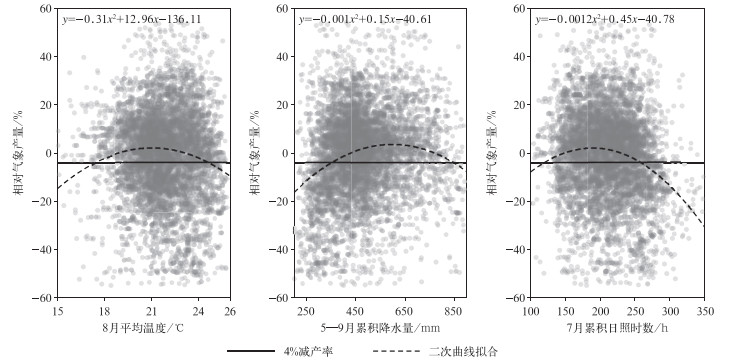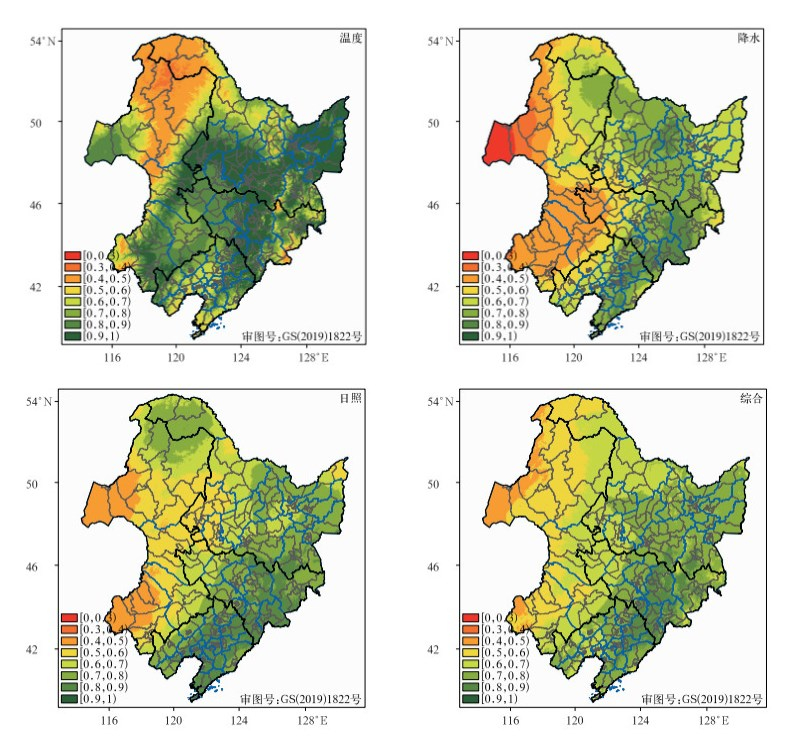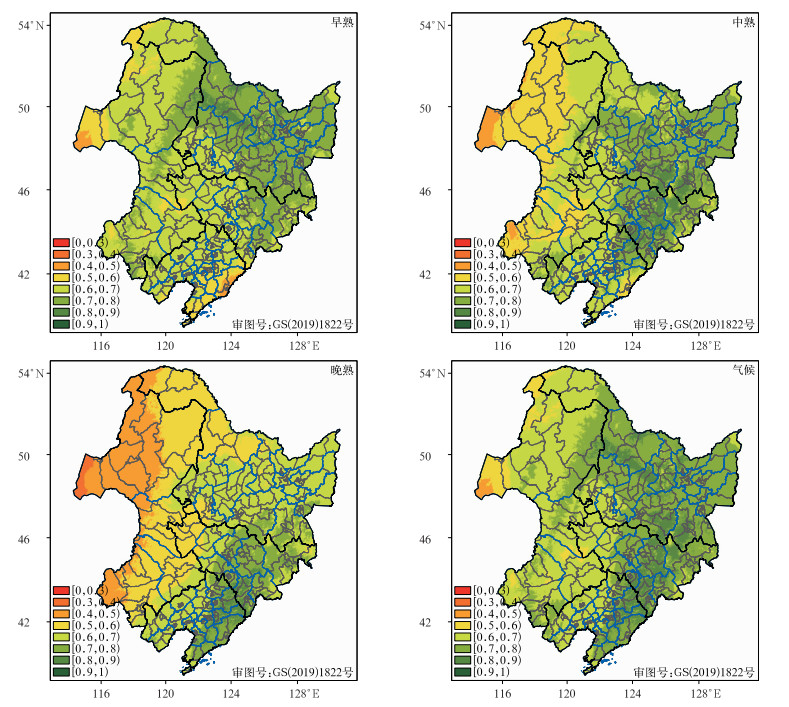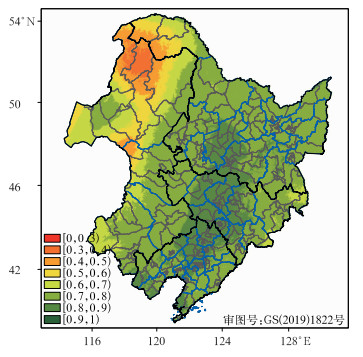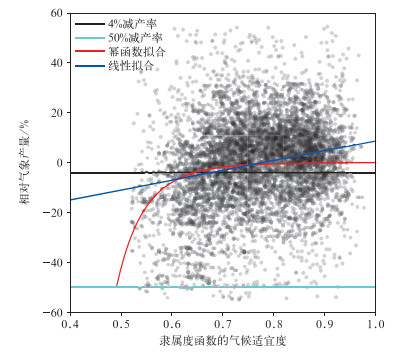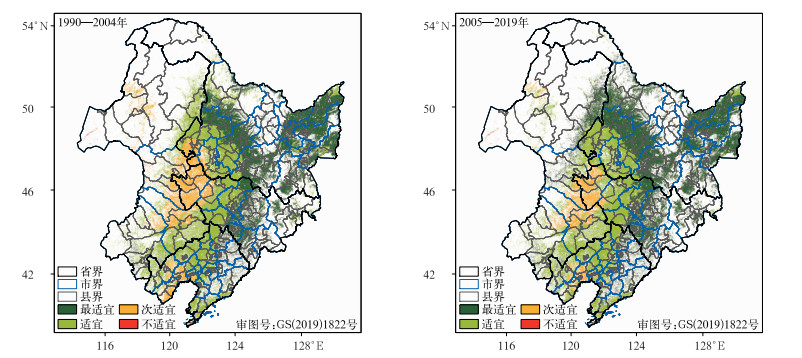Refined Climatic Zoning of Spring Soybean in Northeast China
-
摘要: 以东北春大豆为研究对象,分早熟、中熟和晚熟3类熟型构建东北春大豆气候区划指标。利用基于模糊数学的区划指标隶属度函数和作物反应函数两种气候适宜度评价方法,结合精细化插值(Anusplin插值)后的东北地区1990—2019年气象数据,从时间、空间(1 km×1 km农田)和熟型开展东北春大豆精细化气候区划。结果表明:8月平均温度、5—9月累积降水量和7月累积日照时数是影响春大豆相对气象产量的主要气象要素。分熟型的气候区划结果在表达春大豆单产分布和产量稳定性方面优于不分熟型。根据气候适宜度和减产率的定量关系将适宜度评价结果分为最适宜、适宜、次适宜、不适宜4个等级,其中东北地区最适宜春大豆种植的区域主要集中在松嫩平原的北部和三江平原中南部。随着气候变暖,适宜春大豆种植区域向高纬度和高海拔地区扩大。Abstract: The spring soybean in Northeast China is studied, and its climatic zoning index is determined by multi-year relative meteorological yield and meteorological data considering three maturity types of soybeans: Early, medium and late. Considering the influence of temperature, light and water on soybean growth, two suitability evaluation methods, zoning indicator affiliation function and crop response function, are selected to evaluate the climatic suitability of soybean in Northeast China using meteorological data from 1990-2019 after refined interpolation (Anusplin interpolation). The evaluation results are verified using yield indicators. Climatic zoning class thresholds are determined based on the quantitative relationship between yield reduction rate and suitability of soybeans, and refined climatic zoning is conducted for two time periods, 1990-2004 and 2005-2019. The results show that the average temperature in August, cumulative rainfall from May to September and cumulative sunshine hours in July are the main meteorological factors affecting the relative meteorological yield of soybeans. The climatic zoning indexes for soybean in early, medium and late maturity zones are different. Compared with the results of climate suitability evaluation without maturity type, the evaluation results based on different maturity type indicators are more detailed in spatial distribution and better in expressing the distribution of soybean yields and yield stability. When yield data are lacking, the climate zoning results based on crop response functions is a good complement, which can indicate the distribution of soybean yields, but has shortcomings in the description of yield stability. According to the quantitative relationship between climate suitability and yield reduction rate, the evaluation results are classified as four levels: Most suitable (0.76 ≤ S ≤ 1), suitable (0.65 ≤ S < 0.76), sub-suitable (0.49 ≤ S < 0.65) and unsuitable (0 ≤ S < 0.49). The most suitable areas for soybean cultivation in Northeast China are concentrated in the northern part of the Songnen Plain and the south-central part of the Sanjiang Plain. As the climate warms, areas suitable for soybean cultivation expand to higher latitudes and higher altitudes. Refined climatic zoning of soybean in Northeast China is carried out at three levels: Temporal, spatial (1 km by 1 km farmland), and maturity type. The results of the refined climatic zoning can provide scientific basis for the full and rational use of climate resources and optimization of soybean planting structure in Northeast China.
-
表 1 春大豆各发育阶段三基点温度
Table 1 Triple base point temperature of spring soybean at each reproductive stage
生育阶段 下限温度/℃ 最适温度/℃ 上限温度/℃ 播种-出苗 7 16 26 出苗-三真叶 10 19 30 三真叶-开花 13 22 32 开花-结荚 16 26 32 结荚-鼓粒 14 23 30 鼓粒-成熟 10 18 26 表 2 东北春大豆生长季内气象要素与相对气象产量相关系数
Table 2 Correlation coefficients between meteorological elements and relative meteorological yield during the growing season of spring soybean in Northeast China
时段 温度 降水 日照 5月 -0.28 0.26 0.24 6月 -0.27 0.32 -0.28 7月 0.01 0.37 -0.39 8月 -0.33 0.33 -0.31 9月 0.30 0.15 -0.23 生长季 0.28 0.40 -0.34 表 3 早熟、中熟、晚熟型和东北(不分熟型) 春大豆气候区划指标
Table 3 Climatic zoning indicators for early, medium, late maturing spring soybean regions and the whole area (with no distinction of maturity type) in Northeast China
气象要素 阈值 早熟 中熟 晚熟 东北地区(不分熟型) 适宜下限 17.0 17.6 17.8 17.4 8月平均温度/℃ 最适宜 19.1 20.4 21.3 21.0 适宜上限 21.2 23.2 24.8 24.6 适宜下限 244.3 316.8 372.4 354.4 5—9月累积降水量/mm 最适宜 490.7 550.6 629.9 600.2 适宜上限 737.0 784.2 887.2 845.8 适宜下限 169.5 152.8 86.1 119.4 7月累积日照时数/h 最适宜 233.2 210.4 160.3 188.7 适宜上限 296.9 268.1 234.6 257.9 -
[1] 王彦平, 阴秀霞, 张昉, 等. 内蒙古东北部大豆气候适宜度等级及种植区划研究. 中国生态农业学报, 2018, 26(7): 948-957.Wang Y P, Yin X X, Zhang F, et al. Climate suitability grading and planting zoning of soybean in Northeast Inner Mongolia. Chinese Journal of Eco-Agriculture, 2018, 26(7): 948-957. [2] 王艳杰. 东北三省农作物种植面积变化研究. 哈尔滨: 东北农业大学, 2018.Wang Y J. Study on the Change of Crop Acreage in Three Provinces of Northeast China. Harbin: Northeast Agricultural University, 2018. [3] 莫飞, 王桂霞, 胡明阳. 基于成本视角的东北地区大豆生产现状分析. 大豆科学, 2020, 39(6): 947-953.Mo F, Wang G X, Hu M Y. Analysis of soybean production status in Northeast China based on cost. Soybean Science, 2020, 39(6): 947-953. [4] 张晓慧, 李忠南, 姜海英, 等. 吉林省大豆生产现状及对策. 农业科技通讯, 2019(10): 12-13;155. doi: 10.3969/j.issn.1000-6400.2019.10.003Zhang X H, Li Z N, Jiang H Y, et al. The current situation of soybean production in Jilin Province and countermeasures. Bulletin of Agricultural Science and Technology, 2019(10): 12-13;155. doi: 10.3969/j.issn.1000-6400.2019.10.003 [5] 许佳琦, 郭立峰, 殷世平, 等. 黑龙江省大豆不同生育阶段适宜温度与降水量化指标研究. 东北农业大学学报, 2017, 48(8): 33-44. doi: 10.3969/j.issn.1005-9369.2017.08.005Xu J Q, Guo L F, Yin S P, et al. Study on suitable temperature and precipitation quantification indexes in different soybean growth periods in Heilongjiang Province. Journal of Northeast Agricultural University, 2017, 48(8): 33-44. doi: 10.3969/j.issn.1005-9369.2017.08.005 [6] 林爱兰, 谷德军, 彭冬冬, 等. 近60年我国东部区域性持续高温过程变化特征. 应用气象学报, 2021, 32(3): 302-314. doi: 10.11898/1001-7313.20210304Lin A L, Gu D J, Peng D D, et al. Climatic characteristics of regional persistent heat event in in the eastern China during recent 60 years. J Appl Meteor Sci, 2021, 32(3): 302-314. doi: 10.11898/1001-7313.20210304 [7] Mestre-Sanchís F, Feijóo-Bello M L. Climate change and its marginalizing effect on agriculture. Ecological Economics, 2009, 68(3): 896-904. doi: 10.1016/j.ecolecon.2008.07.015 [8] 李星敏, 柏秦凤, 朱琳. 气候变化对陕西苹果生长适宜性影响. 应用气象学报, 2011, 22(2): 241-248. doi: 10.3969/j.issn.1001-7313.2011.02.013Li X M, Bai Q F, Zhu L. The influence of climate change on suitability of Shaanxi apple growth. J Appl Meteor Sci, 2011, 22(2): 241-248. doi: 10.3969/j.issn.1001-7313.2011.02.013 [9] 周广胜, 何奇瑾, 汲玉河. 适应气候变化的国际行动和农业措施研究进展. 应用气象学报, 2016, 27(5): 527-533. doi: 10.11898/1001-7313.20160502Zhou G S, He Q J, Ji Y H. Advances in the international action and agricultural measurements of adaptation to climate change. J Appl Meteor Sci, 2016, 27(5): 527-533. doi: 10.11898/1001-7313.20160502 [10] 宫丽娟, 李宇光, 王萍, 等. 黑龙江省玉米气候适宜度变化分析. 吉林农业科学, 2012, 37(5): 75-80.Gong L J, Li Y G, Wang P, et al. Variation of climate suitability of maize in Heilongjiang Province. Journal of Jilin Agricultural Sciences, 2012, 37(5): 75-80. [11] Zhao J, Li K W, Wang R, et al. Yield data provide new insight into the dynamic evaluation of maize's climate suitability: A case study in Jilin Province, China. Atmosphere, 2019, 10(6): 305. doi: 10.3390/atmos10060305 [12] 杨显峰, 杨德光, 汤彦辉, 等. 东北春大豆气候适宜性指标体系的建立研究初步. 种子世界, 2009(11): 36-38. doi: 10.3969/j.issn.1000-8071.2009.11.016Yang X F, Yang D G, Tang Y H. Preliminary studies on establishing climatic adaptability index system for spring soybean in Northeast China. Seed World, 2009(11): 36-38. doi: 10.3969/j.issn.1000-8071.2009.11.016 [13] 薛志丹, 孟军, 吴秋峰. 基于气候适宜度的黑龙江省大豆种植区划研究. 大豆科学, 2019, 38(3): 399-406.Xue Z D, Meng J, Wu Q F. Soybean planting division in Heilongjiang Province based on climate suitability. Soybean Science, 2019, 38(3): 399-406. [14] 王纯枝, 霍治国, 张蕾, 等. 北方地区小麦蚜虫气象适宜度预报模型构建. 应用气象学报, 2020, 31(3): 280-289. doi: 10.11898/1001-7313.20200303Wang C Z, Huo Z G, Zhang L, et al. Construction of forecasting model of meteorological suitability for wheat aphids in the northern China. J Appl Meteor Sci, 2020, 31(3): 280-289. doi: 10.11898/1001-7313.20200303 [15] 任玉玉, 千怀遂. 河南省棉花气候适宜度变化趋势分析. 应用气象学报, 2006, 17(1): 87-93. doi: 10.3969/j.issn.1001-7313.2006.01.012Ren Y Y, Qian H S. Climatic suitability of cotton and its changes in Henan Province. J Appl Meteor Sci, 2006, 17(1): 87-93. doi: 10.3969/j.issn.1001-7313.2006.01.012 [16] 程晋昕, 段长春, 闫生杰. 基于MaxEnt模型的薄壳山核桃气候适宜性区划. 应用气象学报, 2020, 31(5): 631-640. doi: 10.11898/1001-7313.20200510Cheng J X, Duan C C, Yan S J. Climate suitability regionalization of pecan based on MaxEnt model. J Appl Meteor Sci, 2020, 31(5): 631-640. doi: 10.11898/1001-7313.20200510 [17] 金林雪, 李云鹏, 吴瑞芬, 等. 基于气候适宜度预报内蒙古大豆发育期及产量. 中国油料作物学报, 2020, 42(5): 903-910.Jin L X, Li Y P, Wu R F, et al. Forecast method of growth stage and yield of soybean based on climate suitability in Inner Mongolia. Chinese Journal of Oil Crop Sciences, 2020, 42(5): 903-910. [18] 卜坤, 王治良, 张树文, 等. 三江平原大豆种植的土地适宜性评价. 中国生态农业学报, 2017, 25(3): 419-428.Bu K, Wang Z L, Zhang S W, et al. Evaluation of agricultural land suitability for soybean cultivation in the Sanjiang Plain, Northeast China. Chinese Journal of Eco-Agriculture, 2017, 25(3): 419-428. [19] 王莹, 张晓月, 焦敏, 等. 基于GIS的辽宁省大豆种植气候区划. 贵州农业科学, 2016, 44(11): 163-166. doi: 10.3969/j.issn.1001-3601.2016.11.037Wang Y, Zhang X Y, Jiao M, et al. Soybean agricultural climate demarcation using GIS technique. Guizhou Agricultural Sciences, 2016, 44(11): 163-166. doi: 10.3969/j.issn.1001-3601.2016.11.037 [20] 何英彬, 姚艳敏, 李建平, 等. 大豆种植适宜性精细评价及种植合理性分析——以东北三省为例. 中国农业资源与区划, 2012, 33(1): 11-17.He Y B, Yao Y M, Li J P, et al. Precisely assessment on soybean growth suitability and analysis on its cultivation reasonability-taking the Northeast China as an example. Journal of China Agricultural Resources and Regional Planning, 2012, 33(1): 11-17. [21] 曲辉辉, 朱海霞, 王秋京, 等. 气候变化对东北三省大豆生育期和产量的影响模拟. 西北农林科技大学学报(自然科学版), 2014, 42(7): 61-69.Qu H H, Zhu H X, Wang Q J, et al. Effects of climate change on soybean growth period and yield in Northeast China. Journal of Northwest A&F University(Natural Science), 2014, 42(7): 61-69. [22] 张艳波, 晁增福, 严志丹, 等. 基于层次分析法的塔里木河流域棉花生产适宜性研究. 数学的实践与认识, 2015, 45(3): 170-175.Zhang Y B, Chao Z F, Yan Z D, et al. Research on suitability index of cotton production in the Tarim River Basin by analytic hierarchy process. Journal of Mathematics in Practice and Theory, 2015, 45(3): 170-175. [23] 谢晓燕, 严春梅, 邓肖任. 基于DEM的桂林市罗汉果气候适宜性分布. 气象科技, 2020, 48(6): 911-916.Xie X Y, Yan C M, Deng X R. Climatic suitability distribution of Momordica grosvenori in Guilin based on DEM data. Meteorol Sci Technol, 2020, 48(6): 911-916. [24] 毕宝贵. 中国精细化农业气候区划. 北京: 气象出版社, 2015.Bi B G. Fine Agricultural Climate Regionalization in China. Beijing: China Metearelogical Press, 2015. [25] 沈国强. 适应气候变化的农作物分布格局研究——以东北地区为例. 长春: 中国科学院大学(中国科学院东北地理与农业生态研究所), 2017.Shen G Q. Research on Crops Pattern for Adapting to Climate Change——A Case Study in Northeast China. Changchun: University of Chinese Academy of Sciences(Northeast Institute of Geography and Agroecology), 2017. [26] 王永利, 侯琼, 苗百岭, 等. 内蒙古马铃薯干旱风险区划. 应用气象学报, 2017, 28(4): 504-512. doi: 10.11898/1001-7313.20170411Wang Y L, Hou Q, Miao B L, et al. Drought risk regionalization of potatoes in Inner Mongolia. J Appl Meteor Sci, 2017, 28(4): 504-512. doi: 10.11898/1001-7313.20170411 [27] 邱美娟, 刘布春, 刘园, 等. 中国北方苹果种植需水特征及降水适宜性. 应用气象学报, 2021, 32(2): 175-187. doi: 10.11898/1001-7313.20210204Qiu M J, Liu B C, Liu Y, et al. Water requirement and precipitation suitability of apple planting in northern China. J Appl Meteor Sci, 2021, 32(2): 175-187. doi: 10.11898/1001-7313.20210204 [28] 张明洁, 赵艳霞. 北方地区日光温室气候适宜性区划方法. 应用气象学报, 2013, 24(3): 278-286. doi: 10.3969/j.issn.1001-7313.2013.03.003Zhang M J, Zhao Y X. The climate suitability zoning method of the solar greenhouse in the northern of China. J Appl Meteor Sci, 2013, 24(3): 278-286. doi: 10.3969/j.issn.1001-7313.2013.03.003 [29] 高红霞. 气候适宜度在内蒙古兴安盟大豆生长气象条件评价中的应用. 内蒙古科技与经济, 2019(13): 52-53.Gao H X. Application of climate suitability in the evaluation of meteorological conditions for soybean growth in Xing'an Meng, Inner Mongolia. Inner Mongolia Science technology & Economy, 2019(13): 52-53. [30] 潘晓卉. 东北地区大豆生产布局变化及影响因素分析. 长春: 中国科学院大学(中国科学院东北地理与农业生态研究所), 2019.Pan X H. Spatio-temporal Variation of Soybean Production in Northeast China and Its Influencing Factors. Changchun: University of Chinese Academy of Sciences(Northeast Institute of Geography and Agroecology), 2019. [31] 王桂芝, 陆金帅, 陈克垚, 等. 基于HP滤波的气候产量分离方法探讨. 中国农业气象, 2014, 35(2): 195-199. doi: 10.3969/j.issn.1000-6362.2014.02.012Wang G Z, Lu J S, Chen K Y, et al. Exploration of method in separating climatic output based on HP filter. Chinese Journal of Agrometeorology, 2014, 35(2): 195-199. doi: 10.3969/j.issn.1000-6362.2014.02.012 [32] 钱永兰, 吕厚荃, 张艳红. 基于ANUSPLIN软件的逐日气象要素插值方法应用与评估. 气象与环境学报, 2010, 26(2): 7-15. doi: 10.3969/j.issn.1673-503X.2010.02.002Qian Y L, Lv H Q, Zhang Y H. Application and assessment of spatial interpolation method on daily meteorological elements based on ANUSPLIN software. Journal of Meteorology and Environment, 2010, 26(2): 7-15. doi: 10.3969/j.issn.1673-503X.2010.02.002 [33] Li K W, Tong Z J, Liu X P, et al. Quantitative assessment and driving force analysis of vegetation drought risk to climate change: Methodology and application in Northeast China. Agr Forest Meteorol, 2020(282/283): 107865. http://www.sciencedirect.com/science/article/pii/S0168192319304812 [34] 吕贞龙, 徐寿军, 庄恒扬. 作物发育温度非线性效应Beta模型的特征分析. 生态学报, 2008, 28(8): 3737-3743. doi: 10.3321/j.issn:1000-0933.2008.08.029Lü Z L, Xu S J, Zhuang H Y. Characteristics of the Beta function for nonlinear effects of temperature on crop phenological development. Acta Ecologica Sinica, 2008, 28(8): 3737-3743. doi: 10.3321/j.issn:1000-0933.2008.08.029 [35] Zhao J, Yang X, Liu Z, et al. Variations in the potential climatic suitability distribution patterns and grain yields for spring maize in Northeast China under climate change. Climatic Change, 2016, 137(1): 29-42. doi: 10.1007/s10584-016-1652-y -


 设为首页
设为首页 加入收藏
加入收藏


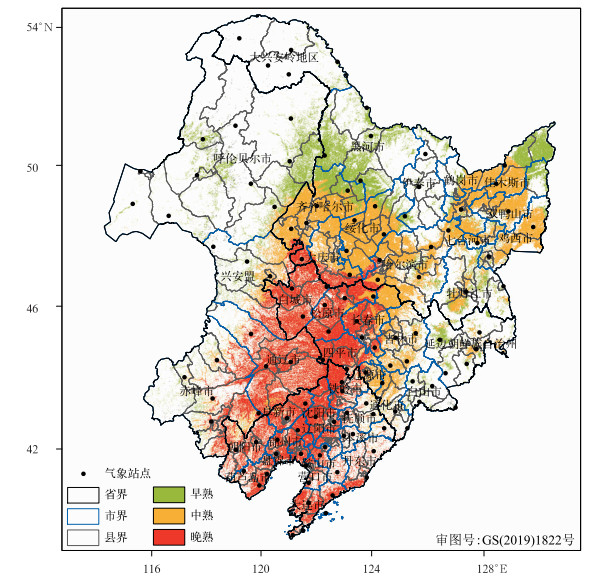
 下载:
下载:
